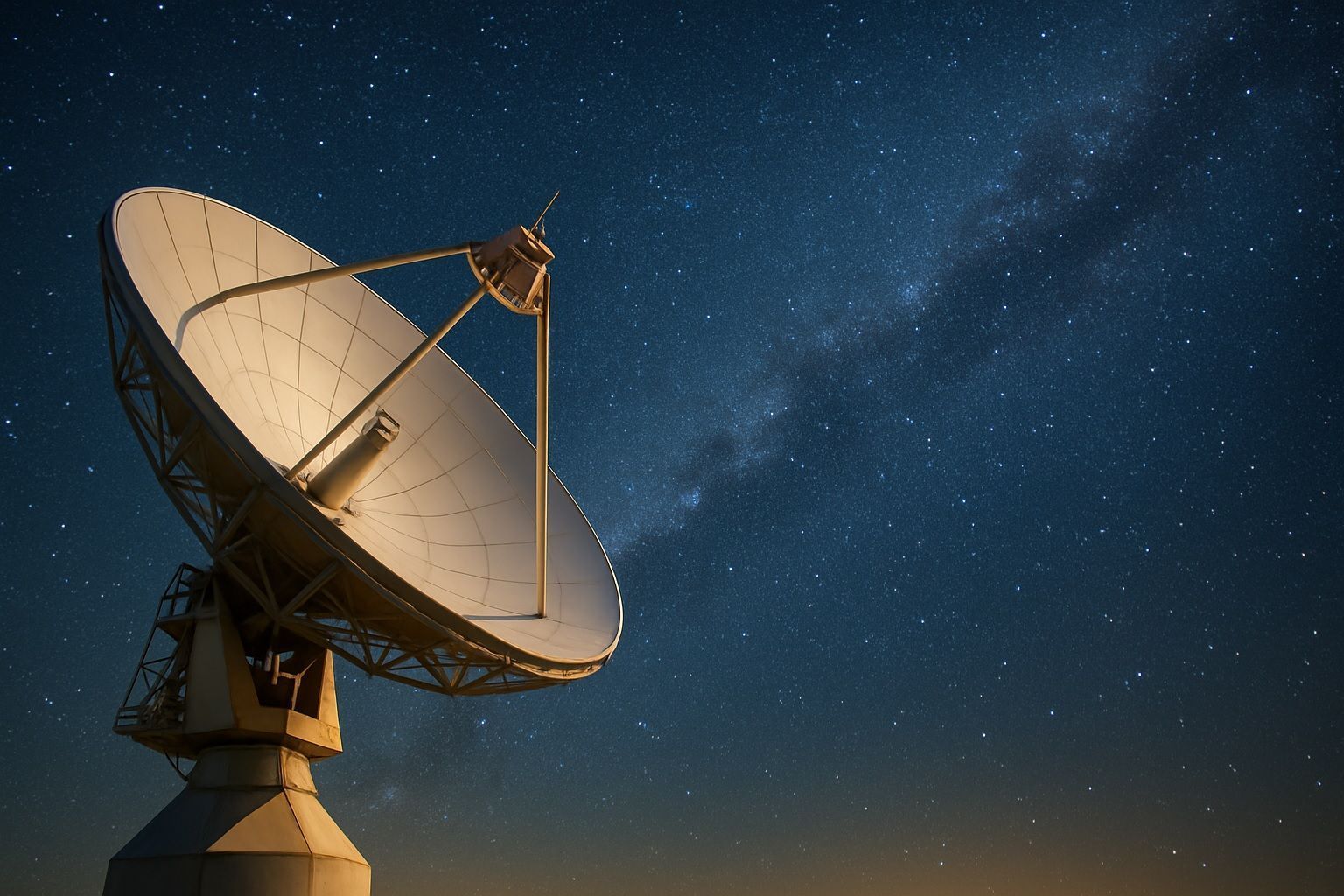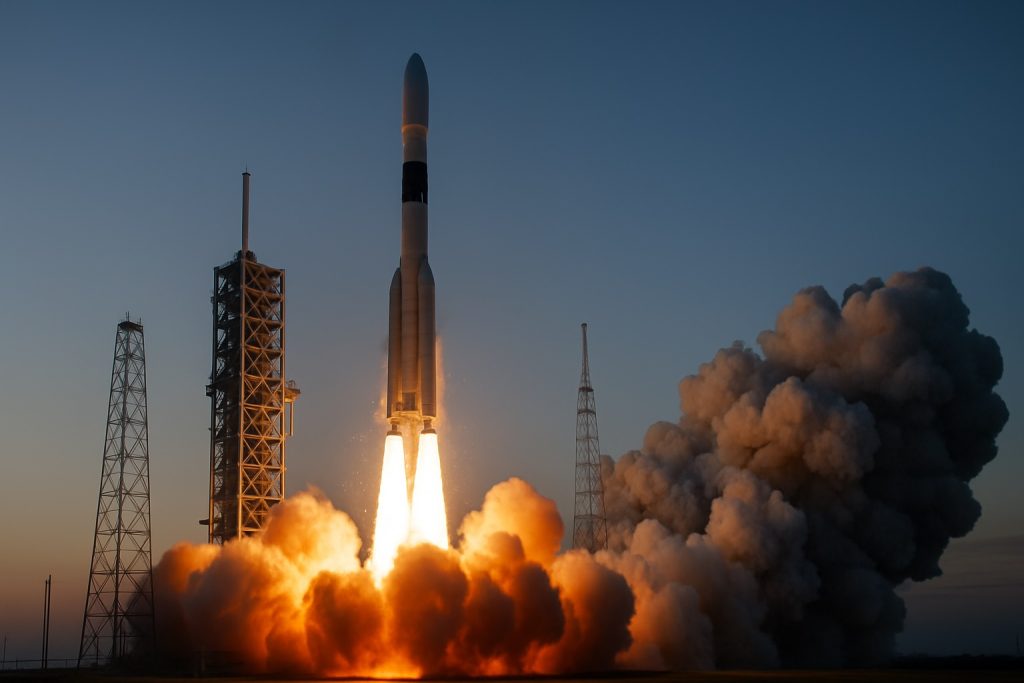- SpaceX’s Starlink network surpassed 7,000 satellites in orbit by June 2025 after a record double launch on June 28, deploying dozens of new satellites from Florida and California within 13 hours.
- Starlink generated $11.8 billion in revenue in 2024, overtaking its launch business for the first time.
- In June 2025 India granted Starlink a license to operate, signaling a major entry into a market projected at $1.9 billion by 2030.
- In May 2025 South Korea approved Starlink and OneWeb for service, with regulators clearing both to start selling LEO internet plans once final certifications are completed.
- France invested €1.35 billion in Eutelsat this year, taking a 29.9 percent stake to bolster OneWeb as a strategic asset for European satcom.
- Eutelsat announced plans to order 100 new LEO satellites to refresh the OneWeb fleet for second-generation capabilities.
- Amazon’s Project Kuiper aims to have half of its planned 3,236 LEO satellites in orbit by July 2026, with terminals promising up to 400 Mbps.
- China launched the fourth group of experimental LEO satellites on June 6, 2025 as part of the Guowang megaconstellation, flying on a Long March 6 from Taiyuan and marking the 580th Long March mission.
- ChinaSat-9C, a GEO broadcasting and broadband satellite, was launched on June 20, 2025 via Long March 3B/E to replace an aging asset and improve domestic broadcasting, TV, radio and internet services.
- The U.S. Space Force canceled the PTS-R large-satellite procurement in early July 2025 in favor of a proliferated LEO approach and began pursuing Space Development Agency mesh satellites and Starshield options.
The past two months have been exceptionally dynamic for the satellite communications (satcom) industry worldwide. From a flurry of satellite launches and constellation deployments to high-stakes mergers, investments, and policy moves, the period saw rapid advances in commercial broadband, military networks, and new IoT applications. Below we break down the major events and trends – including new LEO internet services, strategic corporate shakeups, defense satcom initiatives, and market forecasts – with expert insights and analysis.
Commercial Satcom Soars: Constellations, Markets & Corporate Moves
- LEO Broadband Constellations Race Ahead:SpaceX’s Starlink continued its explosive growth. In late June, SpaceX achieved a record-breaking double launch of Starlink satellites on the same day [1], deploying dozens of new broadband satellites from both Florida and California within 13 hours. Starlink’s total network now exceeds 7,000 satellites in orbit, delivering high-speed internet to consumers, ships, and airplanes [2] [3]. Demand is surging – SpaceX’s Starlink service generated an estimated $11.8 billion revenue in 2024, overtaking its launch business for the first time [4]. Starlink is also entering new markets: in June, India’s telecom ministry granted Starlink a license to operate, a major step into a lucrative market projected at $1.9 billion by 2030 [5] [6]. This came after a long lobbying battle over spectrum policy, where India sided with SpaceX’s view to allocate satellite spectrum by assignment (not auction) – a win for Musk over local telecom rivals [7]. Similarly, South Korea approved Starlink and OneWeb for service in May, requiring them to partner with local providers. By early June, regulators cleared both SpaceX and Eutelsat’s OneWeb to start selling LEO internet plans once final certifications are done [8] [9]. These regulatory greenlights in Asia underscore the global expansion of LEO broadband.
- OneWeb/Eutelsat and the European Push:OneWeb, now merged into Eutelsat, stands as Starlink’s primary global competitor with about 650 satellites in orbit [10]. OneWeb focuses on connecting businesses, communities, and governments (rather than direct-to-consumer), using hub terminals to distribute signals – an approach suited for remote villages, military bases, and inflight or maritime customers [11]. In a dramatic vote of confidence, the French government invested €1.35 billion in Eutelsat this year, taking a 29.9% stake to bolster OneWeb as a “strategic asset” for sovereign European satcom capabilities [12]. France’s backing is predicated on ensuring an independent broadband option so Europe isn’t reliant on foreign-operated constellations. Eutelsat is already planning OneWeb’s second-generation satellites – 100 new LEO craft have been ordered to refresh the fleet and improve performance in coming years [13]. “Whether in a nomadic tent on the plateau or a fishing boat’s cabin at sea, a single satellite antenna enables information access across vast distances,” noted a China Satcom representative, emphasizing the reach of modern satcom networks [14]. (Notably, Eutelsat admits OneWeb cannot fully replace Starlink in certain uses – e.g. Ukraine – but Europe’s IRIS² program, a €11 billion multi-orbit constellation, is in the works to assure secure regional coverage [15].) Meanwhile Amazon’s Project Kuiper is poised to join the fray: after launching test satellites, Kuiper aims to have half of its planned 3,236 LEO satellites in orbit by July 2026 [16]. Amazon touts cheaper, smaller user terminals (promising up to 400 Mbps) to compete with Starlink’s offerings [17]. Though behind in deployment, Kuiper’s entry (along with Canada’s upcoming Telesat Lightspeed network) signals that the LEO broadband race will only intensify.
- Geo Satellites & New Operators: Traditional geostationary (GEO) communications satellites are far from obsolete – but the business is evolving. In June 2025, China launched ChinaSat-9C on a Long March-3B rocket [18], a next-gen GEO satellite to boost domestic broadcasting and broadband services. This satellite will replace an aging predecessor and is locally built, reflecting China’s drive for self-reliance in satcom tech [19]. It offers improved regional coverage – enabling villagers, nomads, or ships at sea to access TV, radio, and internet across China’s vast geography [20]. Commercial operators like SES, Intelsat, Inmarsat (Viasat) and Eutelsat are pivoting from their legacy satellite-TV models toward data and mobility markets. For example, SES reported Q1 2025 revenue of €509 million (virtually flat, -0.5% YoY) [21] but highlighted €360 million in new contracts for broadband and government services [22], signaling growth in connectivity demand even as video revenues decline. Operators are also partnering with LEO constellations or building their own. Viasat’s 2022 merger with Inmarsat (a ~$7 billion deal) created a multi-orbit fleet spanning GEO, MEO and LEO assets, aiming to offer seamless global coverage for aviation and defense clients. However, integration has challenges – Viasat is still working to recover from an antenna glitch on its ViaSat-3 satellite and to realize synergies with Inmarsat’s network (no major new Viasat launches occurred in June–July). On the other hand, new entrants like Astranis are innovating in GEO: Astranis is deploying small, rapidly-built “MicroGEO” satellites to provide affordable regional internet. The company launched four microsats in 2024 and plans five more by end of 2025, an unprecedented scale-up from 1 to 10 GEO satellites in two years [23]. “This whole industry is scaling up significantly – and so are we,” Astranis VP Christian Keil said, pointing to their model of quick deployment and flexible capacity [24]. Such agile approaches, along with satellite digitalization (moving from analog payloads to fully digital, software-defined systems), are helping traditional satcom operators remain competitive. By digitizing ground infrastructure and satellites, operators can drastically cut costs and improve flexibility. “It’s the exact same transition in satellite – we’re moving away from coaxial cables to Ethernet… It brings a whole lot of cost out,” explains Dan Gizinski of Comtech, highlighting how newer all-digital satellites and ground networks are easier to manage and upgrade [25].
- Global Market Outlook: The commercial satcom market is booming, fueled by these constellation rollouts and new services. The global space economy reached $415 billion in 2024, up 4% from the year prior, with 71% of that driven by commercial satellite activity [26]. Industry forecasts remain bullish: analysts project the space sector to grow to $600 billion–$1 trillion by 2030, depending on how quickly new services (like mega-constellations) scale [27]. Within satcom specifically, broadband internet via satellite is the fastest-growing segment – one report predicts NGSO (non-geostationary) constellations will capture 97% of the maritime connectivity market by 2034, thanks largely to Starlink’s aggressive expansion [28]. Even the historically stable satellite IoT niche is set to explode: global satellite IoT connections reached 7.5 million in 2024 and are expected to grow 26% annually through 2030, pushing satellite IoT revenues to ~$4.7 billion by decade’s end [29] [30]. This optimism is attracting major investment. In June, France’s capital injection into Eutelsat/OneWeb was one high-profile example of government funding. Private capital is also flowing – satcom startups and equipment makers raised significant venture funds in 2025, and satellite operator stocks have been buoyed by the promise of new revenue streams (connectivity for planes, IoT, etc.). SpaceX’s soaring revenues and a recent ~$150 billion valuation (based largely on Starlink’s potential) illustrate investor confidence in satcom’s growth trajectory. Mergers and acquisitions continue reshaping the industry as well: the Eutelsat-OneWeb merger (finalized in late 2023) and Viasat-Inmarsat deal created more integrated giants, and rumors swirl about further consolidation (e.g. could SES and Intelsat tie up?) as operators seek scale. All told, the commercial satcom landscape in mid-2025 is marked by intense competition and rapid growth, with LEO constellations on the rise and GEO players adapting through innovation and strategic alliances.
Defense & Government Satellite Communications Developments
Governments around the world are ramping up investments in secure and resilient satellite communications – often driven by geopolitical tensions and the need for reliable networks for militaries. Global government space budgets hit a record $135 billion in 2024, up 10%, with defense projects as the main driver [31]. June–July 2025 saw several major moves in military satcom:
- U.S. Space Force Reshapes Its Satcom Strategy: In early July, the U.S. Space Force made headlines by canceling a major satellite procurement in favor of a new approach [32]. The program, PTS-R (Protected Tactical Satcom – Resilient), had been a traditional plan to build a few large, anti-jam communications satellites (with Boeing and Northrop Grumman competing for the contract). Citing the need for more agility, the Space Force scrapped PTS-R and is shifting to a “proliferated” strategy using many smaller satellites and leveraging commercial systems [33] [34]. “We are simply looking at alternatives… as to what’s the best way to scale this up to the larger requirements for data transport,” Chief of Space Operations Gen. Chance Saltzman told Congress, explaining the decision to pause buying more big sats while the service evaluates new architectures [35]. One alternative under study is a somewhat secretive project called “MILNET,” a proposed space data network that could include ~500 satellites – potentially built and operated by SpaceX under its Starshield program [36]. In fact, SpaceX’s Starshield (a military-grade version of Starlink) is already on contract to provide satellites, user terminals, and operations for this effort [37]. This has raised concerns in Washington: some senators worry that relying on SpaceX’s private network “has no competition, no open architecture,” potentially undermining the open multi-vendor approach the Pentagon prefers [38]. To keep options open, the Space Force is continuing to deploy the Space Development Agency (SDA)’s Transport Layer as a demonstrator. The SDA – now under Space Force – launched its first 19 prototype tactical communications satellites into LEO in April and is on track to orbit 126 more starting late summer 2025 as part of “Tranche 1” [39]. These small sats (built by multiple contractors) will form a mesh network to relay data for military units, an approach meant to improve resilience against jamming or attack. Another 182 SDA satellites (Tranche 2) are already on contract, though plans to procure a third tranche were put on hold pending the MILNET review [40]. In short, the U.S. is testing a hybrid strategy: one path using its own proliferated LEO constellations with diverse suppliers, and another possibly outsourcing to an existing commercial megaconstellation (Starlink/Starshield) for speed and scale. By boosting funding for space-based comms (nearly $900 million is earmarked for satcom in the 2024–26 defense budget [41]), the Pentagon clearly intends to have many more communication satellites in orbit – and ones that can survive contested environments. This includes not just LEO sats, but also new jam-resistant GEO satellites for strategic communications. On July 4, the U.S. Air Force awarded Boeing a $2.8 billion contract to build the next-generation Evolved Strategic Satcom (ESS) satellites [42]. These ESS satellites will be central to nuclear command & control communications, linking the U.S. national command authority with nuclear forces [43]. Boeing beat out Northrop for this vital program, and the hefty contract underlines the priority placed on hardened, resilient satcom for deterrence. Between ESS for nuclear C3, DoD’s wideband satcom programs, and new LEO initiatives, U.S. military satcom is undergoing a comprehensive modernization.
- Allied and Other Nations’ Military Satcom: America’s partners are likewise updating their satellite communications. NATO and European defense planners, spooked by Russia’s jamming and the reliance on SpaceX Starlink during the Ukraine conflict, have been seeking more sovereign capabilities. The EU’s IRIS² constellation (mentioned above) is partly aimed at government use, ensuring European militaries and civil protection agencies have a secure satcom network by late 2020s [44]. In the Asia-Pacific, Australia made a bold move last November by canceling a A$5 billion (~USD $3.3B) contract with Lockheed Martin for a large military commsat, deeming the single GEO satellite approach outdated [45]. Instead, Australia is expected to pursue a multi-satellite, multi-orbit solution (potentially partnering with U.S. or commercial LEO constellations) that offers more resilience and flexibility. Japan, similarly, is considering augmenting its “Kirameki” military comsats with new satellites or hosted payloads to improve capacity for its Self-Defense Forces. China and Russia, for their part, continue to invest heavily in military satcom – though details are murky. China’s recently launched LEO test constellations (see below) likely have dual-use implications for military communications and ISR. In June, China launched a batch of experimental LEO comsats (the fourth group in an ongoing series) on a Long March-6 from Taiyuan [46] as part of its planned “Guowang” megaconstellation. Guowang is envisioned as China’s answer to Starlink – thousands of satellites to provide global internet and secure comms, including to the PLA. According to state media, the June 6 launch successfully deployed the latest group of satellites into orbit [47], marking the 580th Long March rocket mission. China is also rolling out dedicated military comm satellites in GEO: besides the ChinaSat series (for civilian use), it has launched Tongxin Jinzhan (TJS) and Fenghuo satellites believed to serve strategic military communications, data links for UAVs, and secure comms for forces. India, while relying on some foreign services (like leasing capacity from Inmarsat), is working on its GSAT series of comm sats and considering LEO options for the Indian military and rural connectivity. In 2025, India’s Space Research Organisation (ISRO) planned launches of GSAT-24 and GSAT-32 to enhance broadband and tactical communications coverage for the subcontinent (though these launches moved to late 2025). Many developing countries are also entering the satcom arena with small satellites to support government comm needs – from Indonesia’s Palapa NG satellites to Brazil’s Amazônia SATCOM initiative.
- Secure Communications and Alliances: A key theme is alliances and interoperability. NATO is coordinating members’ satcom resources under its “Alliance Future Surveillance and Control” and related programs to ensure forces can communicate seamlessly. The UK, for example, has its Skynet 6 military satcom upgrade in progress (a new Skynet-6A satellite built by Airbus is slated for launch around late 2025). France operates the Syracuse-4 secure satellites (with Italy and Belgium as partners on Athena-Fidus and other projects), and is contributing to the EU GovSatCom initiative. Private sector defense deals are also ramping up: in June, Viasat (US) announced it had signed a multi-year contract to use Telesat’s upcoming Lightspeed LEO network for certain defense customers, as a complement to Viasat’s own fleet [48]. And in Australia, telecom operator Vocus inked a June deal with Canada’s Telesat to build a ground station and provide fiber connectivity for the Lightspeed network down under [49] [50]. This partnership will allow Australian defense and enterprise users to access Telesat’s LEO satellites with high security and low latency. A unique feature of Lightspeed is end-to-end encrypted links with optical inter-satellite lasers – for instance, a naval vessel could communicate through Lightspeed directly to troops on land without touching any terrestrial internet, preserving data sovereignty [51]. “This capability will be extremely valuable to customers with mission-critical communications requirements,” said Vocus’s head of space operations, highlighting the appeal for defense users [52]. Such collaborations show how commercial constellations are being integrated into national defense architectures. In the U.S., SpaceX’s Starlink already provides services to military units in remote areas (and was notably leveraged in Ukraine for tactical comms). The Pentagon is now working on contracts under its Commercial Satellite Communications Office (CSCO) to buy LEO broadband services as a managed service, rather than relying solely on owning satellites. This trend blurs the line between “military” and “commercial” satcom – a deliberate move to tap into the innovation and capacity of the private sector while securing dedicated bandwidth for government use.
In summary, satellite communications for defense are shifting toward resilience, redundancy, and partnerships. Multiple allied nations are pursuing proliferated LEO systems to complement their traditional military satellites, ensuring that if one node is knocked out, others can fill in (a lesson reinforced by observing tactics in the Russia-Ukraine war). At the same time, big contracts like Boeing’s ESS or Europe’s IRIS² show that strategic, sovereign capabilities remain critical for nuclear C3 and government communications. We can expect continued growth in government satcom spending, more international cooperation (and some competition) on secure networks, and further adoption of commercial tech (like SpaceX, OneWeb, etc.) into military communication infrastructure.
Technology Trends & New Applications: Satellite Internet, IoT and Beyond
Beyond the big commercial and defense stories, June–July 2025 brought exciting advances in satellite technology integration – from connecting everyday devices to space networks, to enabling phones and IoT sensors to talk to satellites, and improving how satellites themselves operate. Here are key tech trends and innovations:
- Satellites for Every Device – the Rise of IoT and Direct-to-Device Services: A major trend is extending internet-of-things (IoT) connectivity and mobile coverage to 100% of the globe via satellite. In June, Kinéis – a French startup – officially launched the world’s first dedicated IoT satellite constellation service [53]. Kinéis’s 25 nanosatellites (in polar orbits) are now providing low-power connectivity for sensors and asset trackers, allowing companies to monitor things like shipping containers, livestock, or environmental sensors in real time from space. This “hybrid IoT” approach, combining terrestrial networks with satellites, is becoming essential for seamless global coverage [54]. Industry analysts forecast satellite IoT connections will grow to tens of millions, with uses in agriculture, logistics, energy infrastructure, and defense – anywhere ground networks fall short [55] [56]. One remarkable project comes from China: a Beijing-based firm Bluelink Satcom announced plans to orbit the world’s first Bluetooth-compatible satellites starting in July 2025 [57]. The idea is to pick up standard Bluetooth Low Energy (BLE) signals from off-the-shelf IoT devices on the ground. With a constellation of 72 “Bluetooth sats” by 2028, even a simple sensor or smartphone could potentially relay data to orbit with just a firmware update, no special satcom terminal needed [58]. If successful, this could unlock satellite connectivity for billions of existing devices – a truly game-changing integration of consumer tech with space. More broadly, satellite providers are embracing open standards. For instance, some LEO IoT constellations now support 5G NB-IoT protocols, enabling 5G IoT modules to roam onto satellites. In fact, the 3GPP 5G Release-17 defined “NTN” (non-terrestrial network) standards to natively support satellites. Companies like Spain’s Sateliot launched 5 nano-satellites in July 2025 to create an orbital NB-IoT network, aiming to work seamlessly with terrestrial telecom operators [59]. All these efforts point to a future where satellites become an invisible extension of the internet, ensuring that even in the middle of an ocean or desert, devices stay connected.
- Direct-to-Cellphone Satellite Internet: Hand in hand with IoT, the concept of satellite-to-phone service has leapt forward. In 2023, we saw Apple partner with Globalstar to enable emergency SOS messaging via satellite in iPhones, and startups like AST SpaceMobile achieved the first ever satellite 4G phone call. Now in 2025, larger initiatives are underway. SpaceX’s Starlink has a project with T-Mobile to directly connect smartphones for texting using Starlink’s next-gen satellites (Starlink V2 satellites, launched starting mid-2023, include antennas for cellular bands). OneWeb too, through its shareholder Bharti Airtel, is exploring sat-to-mobile for rural India and Africa. Regulators are preparing: the U.S. FCC advanced a “Supplemental Coverage from Space” framework to integrate satellite capacity with terrestrial cell networks [60]. This would allow mobile carriers to partner with satellite operators so that a customer’s phone automatically switches to a satellite signal when out of cell tower range. Several such partnerships have formed: in June, AT&T announced it will use AST SpaceMobile’s upcoming BlueBird satellites to provide direct smartphone connectivity, and in Japan, carrier SoftBank is working with Skylo and others for satellite IoT backhaul. South Korea’s June approval for Starlink/OneWeb explicitly was aimed at improving rural 5G coverage via satellite links [61] [62]. As these services roll out (some as soon as late 2025), consumers might soon experience ubiquitous coverage – your 5G phone could get a signal on a mountaintop or mid-ocean, thanks to satellite relays. There are technical hurdles (spectrum allocation, small handset antennas, etc.), but progress is steady. “The industry has made significant strides integrating satellite technology into the 5G ecosystem,” notes one satcom executive, and the focus now is on “supporting next-gen connectivity and direct-to-device capabilities” without burdening users with complexity [63]. In short, satellites and terrestrial wireless are converging. The next few years will likely see hybrid phone plans (terrestrial + satellite) become common, especially for emergency responders, remote communities, and IoT deployments.
- Advanced Ground and Optical Networks: Another area of innovation is on the ground segment and inter-satellite links. As satellites proliferate, managing thousands of beams and connections requires smart ground infrastructure. Cloud-based satellite control and digital beamforming are being adopted to flexibly allocate capacity on demand. The U.S. Space Force, for example, is testing cloud-native ground station software and “smart” constellation management so that military satcom can dynamically route around interference [64]. Companies like SES and Intelsat are investing in ground network virtualization to let user terminals roam across GEO, MEO, and LEO satellites seamlessly. In orbit, laser communications are becoming standard on new constellations – Starlink uses laser crosslinks to route data in space, reducing reliance on ground relays and cutting latency. Telesat Lightspeed will use an all-optical mesh between satellites for security and speed [65]. And NASA is experimenting with laser comm for deep space: though not in this period’s news, it’s notable that NASA’s LCRD relay has been testing 1.2 Gbps laser links with the International Space Station, a precursor to high-data lunar comms under Artemis. The emphasis across the board is on network resilience and speed. By orchestrating large fleets of satellites with AI and linking them via optical links, providers can offer fiber-like performance from space, which is crucial for real-time applications like drone control, tactical military data, and high-frequency trading networks.
- Satellite & Ground Station Innovations: On the more experimental side, a fascinating development is the use of spin-out tech from satcom for scientific missions. While not exactly “communications,” consider NASA’s Delay/Disruption Tolerant Networking (DTN) tests on the International Space Station – essentially an internet protocol for space communications that could one day interconnect satellites, lunar bases, and Mars rovers in an “Interplanetary Internet.” In June 2025, NASA highlighted progress in DTN and autonomous networking that came out of satcom research, now being applied to control swarms of scientific satellites. Likewise, the ESA has been working on quantum encryption via satellites (the HydRON project), aiming to secure communications with quantum keys distributed from space – blending cutting-edge physics with comms tech. Back on Earth, ground stations are also evolving: antenna makers are rolling out flat-panel electronically steered antennas to enable moving vehicles (cars, planes, boats) to stay linked to LEO constellations without mechanical dishes. Companies like OneWeb and Starlink have partnered with antenna firms to develop low-cost, mass-producible phased array terminals – a crucial step to reach more customers. In June, Eutelsat OneWeb’s partner Intellian Technologies (Korea) unveiled a line of OneWeb user terminals manufactured domestically, coinciding with the service launch in South Korea [66]. Intellian’s CEO Eric Sung lauded Korea’s licensing of LEO service as “a major inflection point for the region… proving that LEO is now fully operational, scalable, and commercially impactful” [67]. This illustrates how regulatory support + local tech development go hand in hand to drive adoption of new satcom services.
Finally, it’s worth noting how satellite communications are intersecting with other sectors: for example, maritime and aviation industries are seeing a revolution as high-throughput satellites bring broadband to every ship and airplane. In-flight Wi-Fi providers like GoGo and Viasat are launching new plans leveraging LEO constellations for lower latency. The Internet of Military Things (IoMT) is another emerging area – tiny sensors on battlefields linking through satellites to give commanders real-time info. All these integrations underscore a core truth: satellites are becoming an integral part of global connectivity, not a niche last-resort. As one industry expert put it, “For the industry at large, [recent developments] brought back the importance of the overall user experience – not just any connectivity, but meaningful improvements to connectivity” [68]. In other words, the goal now is to make satellite links as easy, reliable, and high-performance as any other network, so that users might not even realize their data traveled via space.
Major Launches & Missions (June–July 2025)
To summarize the launch activity of note in this period, the table below highlights major satellite launches relevant to communications and the missions behind them:
| Date (2025) | Satellite / Mission | Operator / Nation | Launch Vehicle | Orbit | Purpose |
|---|---|---|---|---|---|
| June 6 | LEO Internet Constellation – Batch 4 (several small sats) | China (CASC – “Guowang” program) | Modified Long March 6 (Taiyuan) [69] | LEO | Experimental broadband constellation test; part of China’s Starlink-rival network. |
| June 20 | ChinaSat-9C (Zhongxing-9C) | China Satcom (CASC) | Long March 3B /E (Xichang) [70] [71] | GEO | Communications/Broadcast satellite – enhances China’s domestic TV, radio & internet services (replacing an older satellite). |
| June 28 | Starlink Group 1 (batch launch) | SpaceX (USA) | Falcon 9 (Cape Canaveral) | LEO | Starlink broadband deployment – dozens of internet satellites for global consumer service [72]. |
| June 28 | Starlink Group 2 (batch launch) | SpaceX (USA) | Falcon 9 (Vandenberg SFB) | LEO | Starlink broadband deployment – second launch within ~13 hours (demonstrating unprecedented rapid reuse) [73]. |
| July 1 | OneWeb Gen1 (Phase 1 complete) | Eutelsat OneWeb (EU/UK) | [Constellation fully deployed] | LEO | Satellite internet – OneWeb’s 648 satellites now in orbit provide global broadband for enterprise/government (no launches in June–July; constellation reached near-full capacity earlier in 2025) [74]. |
| July ?? (Planned) | “BlueWalker 4” Direct-to-cell Satellite | AST SpaceMobile (USA) | Falcon 9 (Kennedy Space Center) | LEO | Mobile communications – test satellite for 4G/5G direct-to-phone service (following AST’s earlier BlueWalker 3 demo). |
Table: Major satcom-related launches in June–July 2025, including their missions and significance. (OneWeb’s constellation is included for context, though no OneWeb launches occurred in these two months.)
Note: In addition to the above, other launches occurred (Rocket Lab flights carrying Hawkeye 360 RF-signal mapping microsats, various small CubeSats, etc.), but those listed were especially relevant to satcom services. Also, BlueWalker 4 is a planned launch by AST SpaceMobile in mid-2025 to expand direct-to-cell testing – part of the trend of satellites connecting directly to everyday devices.
Outlook and Conclusion
The flurry of activity in summer 2025 makes one thing clear: satellite communications has entered a new era of rapid growth and transformation. Commercially, incumbent operators and NewSpace upstarts alike are launching more satellites than ever, vying to connect everyone and everything, everywhere. The LEO constellation boom – led by Starlink and followed by OneWeb, Kuiper, Lightspeed and others – is driving prices down and performance up, bringing in untapped customers (from airlines to developing countries) and posing healthy competition to terrestrial telecom in remote areas [75] [76]. In parallel, government and military users are reshaping their strategies to leverage these new systems while also investing in their own secure satcom assets, aiming for resilient “network-of-networks” architectures that can withstand hostile interference [77] [78].
Policy makers have been kept busy adjusting regulations to this fast-moving sector – from spectrum rules and licensing regimes to partnerships enabling cross-border satellite services. The recent licenses for Starlink and OneWeb in India and Korea exemplify regulators embracing satellite broadband to bridge digital divides [79] [80], while the FCC and others work on frameworks to integrate satellites into mainstream mobile networks. At the same time, concerns about space sustainability (managing orbital debris with so many new satellites) and fair spectrum sharing are growing. In these two months, we’ve seen international discussions (at the UN’s COPUOS and ITU forums) about megaconstellation traffic management, and companies like SpaceX reporting efforts to de-orbit defunct satellites (Starlink had de-orbited 472 satellites by mid-2025 as part of responsible operations) [81]. Expect more focus on safety and coordination as thousands more satcom satellites launch.
On the financial front, the satcom industry is attracting record levels of investment and revenue. Market analysts are increasingly bullish that satellite connectivity will be a key pillar of the global digital infrastructure, not a niche. If current growth rates hold, satcom firms will enjoy strong revenue expansion through the end of the decade, especially in broadband and IoT segments [82] [83]. However, competition is fierce – operators must execute well to win market share and manage costs (as cheap launch by SpaceX has enabled Starlink’s expansion, others will rely on cost-effective manufacturing and partnering). Mergers, vertical integration, and even some shakeouts are likely as weaker players get absorbed. We have already witnessed major consolidation, and further deals could occur if, for instance, a big GEO operator decides it needs a LEO network (or vice versa).
In conclusion, June–July 2025 showcased a satellite communications sector in full throttle – launching more satellites, serving more users, and pushing more technological boundaries than ever before. From a clickbait-worthy perspective, one might say “The Satellite Internet Gold Rush is on” [84], and indeed it is apt: every 2–3 days a rocket lifts more satellites for SpaceX alone, and many others are following suit [85]. The world’s insatiable hunger for connectivity – broadband, streaming, telemedicine, smart farming, national security links – is extending into space, and companies old and new are racing to stake their claim. The period’s developments in commercial, military, and scientific domains all point toward a more connected planet (and beyond), with satellites serving as the critical backbone. As expert observers have noted, it’s not just about putting more satellites up; it’s about truly improving people’s lives and safety through better connectivity [86] [87] – whether that means a remote village school finally getting internet via satellite, a soldier in the field maintaining a secure link, or a sensor network detecting floods in a rainforest. The satcom revolution of 2025 is well underway, and it is reshaping how our world communicates at every level.
Sources:
- SpaceNews – Commercial & Military Satcom Updates (June–July 2025) [88] [89]
- Reuters – “Musk’s Starlink gets India licence to offer satcom services” (June 6, 2025) [90] [91]
- Orbital Today – “Starlink and OneWeb Enter South Korea…” (June 4, 2025) [92] [93]
- Advanced Television – “France backs OneWeb” (July 1, 2025) [94] [95]
- DefenseNews – “Space Force rethinking plans for proliferated satcom” (June 27, 2025) [96] [97]
- SpaceNews – “Space Force scraps satcom procurement, shifts strategy” (July 6, 2025) [98] [99]
- SpaceNews – “Boeing lands $2.8B deal for nuclear comm satellites” (July 4, 2025) [100]
- TS² Space Tech – Global Space Industry Report 2025 (June 1, 2025) [101] [102]
- TS² Space News – “Space News Roundup – June 29, 2025” [103]
- People’s Daily (Xinhua) – “ChinaSat-9C… bolsters broadcasting” (June 23, 2025) [104] [105]
- Gov.cn (Xinhua) – “China launches internet satellite group” (June 6, 2025) [106]
- IoT Analytics – “Satellite IoT market to $4.7B by 2030: 5 drivers” (June 17, 2025) [107] [108]
- SatNews – “Vocus & Telesat Lightspeed contract” (June 10, 2025) [109] [110]
- Advanced Television – “South Korea grants licence for OneWeb LEO” (June 3, 2025) [111] [112]
- Payload – “The State of Satcom 2025” (Apr 1, 2025) [113] [114]
- Kinéis – Company News (June 2, 2025) [115] [116]
References
1. ts2.tech, 2. www.advanced-television.com, 3. payloadspace.com, 4. spacenews.com, 5. www.reuters.com, 6. www.reuters.com, 7. www.reuters.com, 8. orbitaltoday.com, 9. orbitaltoday.com, 10. www.advanced-television.com, 11. www.advanced-television.com, 12. www.advanced-television.com, 13. www.advanced-television.com, 14. en.people.cn, 15. payloadspace.com, 16. www.advanced-television.com, 17. www.advanced-television.com, 18. en.people.cn, 19. en.people.cn, 20. en.people.cn, 21. www.ses.com, 22. techafricanews.com, 23. payloadspace.com, 24. payloadspace.com, 25. payloadspace.com, 26. ts2.tech, 27. ts2.tech, 28. www.copernical.com, 29. iot-analytics.com, 30. iot-analytics.com, 31. spacenews.com, 32. spacenews.com, 33. spacenews.com, 34. spacenews.com, 35. www.defensenews.com, 36. www.defensenews.com, 37. www.defensenews.com, 38. www.defensenews.com, 39. www.defensenews.com, 40. www.defensenews.com, 41. payloadspace.com, 42. spacenews.com, 43. spacenews.com, 44. payloadspace.com, 45. payloadspace.com, 46. english.www.gov.cn, 47. english.www.gov.cn, 48. runwaygirlnetwork.com, 49. news.satnews.com, 50. news.satnews.com, 51. news.satnews.com, 52. news.satnews.com, 53. www.kineis.com, 54. www.kineis.com, 55. iot-analytics.com, 56. iot-analytics.com, 57. ts2.tech, 58. ts2.tech, 59. sateliot.space, 60. www.fcc.gov, 61. orbitaltoday.com, 62. orbitaltoday.com, 63. payloadspace.com, 64. spacenews.com, 65. news.satnews.com, 66. www.advanced-television.com, 67. www.advanced-television.com, 68. payloadspace.com, 69. english.www.gov.cn, 70. en.people.cn, 71. en.people.cn, 72. ts2.tech, 73. ts2.tech, 74. www.advanced-television.com, 75. www.advanced-television.com, 76. payloadspace.com, 77. www.defensenews.com, 78. www.defensenews.com, 79. www.reuters.com, 80. orbitaltoday.com, 81. www.advanced-television.com, 82. iot-analytics.com, 83. www.copernical.com, 84. restofworld.org, 85. restofworld.org, 86. payloadspace.com, 87. payloadspace.com, 88. spacenews.com, 89. spacenews.com, 90. www.reuters.com, 91. www.reuters.com, 92. orbitaltoday.com, 93. orbitaltoday.com, 94. www.advanced-television.com, 95. www.advanced-television.com, 96. www.defensenews.com, 97. www.defensenews.com, 98. spacenews.com, 99. spacenews.com, 100. spacenews.com, 101. ts2.tech, 102. ts2.tech, 103. ts2.tech, 104. en.people.cn, 105. en.people.cn, 106. english.www.gov.cn, 107. iot-analytics.com, 108. iot-analytics.com, 109. news.satnews.com, 110. news.satnews.com, 111. www.advanced-television.com, 112. www.advanced-television.com, 113. payloadspace.com, 114. payloadspace.com, 115. www.kineis.com, 116. www.kineis.com










